11 November 2021
Skid row is a term for a run-down area of a town where the unemployed, vagrants, alcoholics, tend to congregate. It is American in origin. Most sources will point to the older skid road, a logging road that is “paved” with logs over which trees can be dragged, as the inspiration, but while skid road certainly was an influence, a more important influence was the phrase hit the skids.
In nineteenth-century logging lingo, a skid was a tree trunk laid perpendicular across a road over which logs could be dragged. We can see this use of skid in an 1851 book about forestry in Maine and New Brunswick:
In constructing this road, first all the underbrush is cut and thrown on one side; all trees standing in its range are cut close to the ground, and the trunks of prostrated trees cut off and thrown out, leaving a space from ten to twelve feet wide. The tops of the highest knolls are scraped off, and small poles, called skids, are laid across the road in the hollows between.
And we see skid road applied to a road that is paved with skids in the Morning Oregonian of 27 February 1877:
Some time during last season one putting in saw logs on the Weatherby place, for a long distance cross-laid the road with round timbers 10 to 12 inches in diameter placed about six feet apart and about half buried beneath the ground, making what loggers call a “skid road.” This does very well for hauling logs on, but not very interesting for wagons to pass over.
The use of skid road was particularly prevalent in the Pacific Northwest, undoubtedly due to that region’s heavy reliance on the logging industry.
But the association between skids and sliding garnered another sense, that of sliding into failure or defeat. We see this sense in baseball writing at the turn of the twentieth century in the phrase hit the skids, meaning to go into a slump. From an article in the Rockford Morning Star of 5 August 1906 about the world champion New York Giants:
Bowerman had his friends in the club, and they resented McGraw’s partiality toward Bresnahan. Ever since this incident the world’s champions have been arrayed into two factions, one bunch being with Bresnahan and the other being well-disposed toward Bowerman. The latter is a great hitter and catcher, and is giving McGraw the best he had in stock this season, but “insiders” regard it as significant that Sammy Mertes, one of Bowerman’s closest friends, was the first to hit the “skids” when McGraw started out to say that Roger [Bresnahan] can discount Bowerman with the bat.
Two years later, the Giants were in another slump. From the St. Louis Post-Dispatch of 18 May 1908:
New York seems to have hit the skids for Cellarville or near it. Cincinnati is playing improved ball and Wiltse could not hold the Reds in check yesterday.
And by 1921 we start to see skid row being used to refer to the section of a city where those who have hit the skids and become homeless congregate. From Almira Bailey’s 1921 Vignettes of San Francisco:
They say that San Francisco is the known all over as the Port O’ Missing Men. That is, a city where a man may lose himself if he chooses, and that by the same token it is a good place to look for my wandering boy tonight. I can believe all this especially on Third street. Third street should be called by some other name or it should have a nickname. If it were Seattle it would be known as “skid row.” Third street doesn’t describe it at all.
When I see a lot of men like that, wanderers, family men out of work, vagabonds, nobodies, somebodies, “rich man, poor man, beggar man, thief; doctor, lawyer, merchant chief,” I always get to thinking how once each one was a tiny baby in a thin white dress, and how before that each one was born of a woman.
It’s clear from reading these paragraphs that Bailey did not coin skid row and that it was in use in Seattle, if not elsewhere as well. The earlier use of skid road may have played a part in the coining or the popularity of skid row. And any use in Seattle may have especially been influenced by the logging term, given that industry’s importance to the region. But the more apropos metaphor remains that of hitting the skids and being down on one’s luck.
Sources:
Bailey, Almira. Vignettes of San Francisco. San Francisco: San Francisco Journal, 1921, 21. HathiTrust Digital Archive.
Dictionary of American Regional English, 2013, s.v. skid road, n.
“Giants Have Slump.” Rockford Morning Star (Illinois), 5 August 1906, 10. Readex: America’s Historical Newspapers.
Green’s Dictionary of Slang, 2021, s.v. skid row, n., skids, n.
Oxford English Dictionary, second edition, 1989, s.v. skid row, n., skid, n.
“The Road Down the River.” Morning Oregonian (Portland), 27 February 1877, 2. Readex: America’s Historical Newspapers.
“Sidelights on the Game.” St. Louis Post-Dispatch, 18 May 1908, 10. ProQuest Historical Newspapers.
Springer, John S. Forest Life and Forest Trees. New York: Harper and Brothers, 1851, 84. HathiTrust Digital Archive.
Image credit: The Erica Chang, 2001. Licensed under a Creative Commons Attribution 3.0 Unported license.





